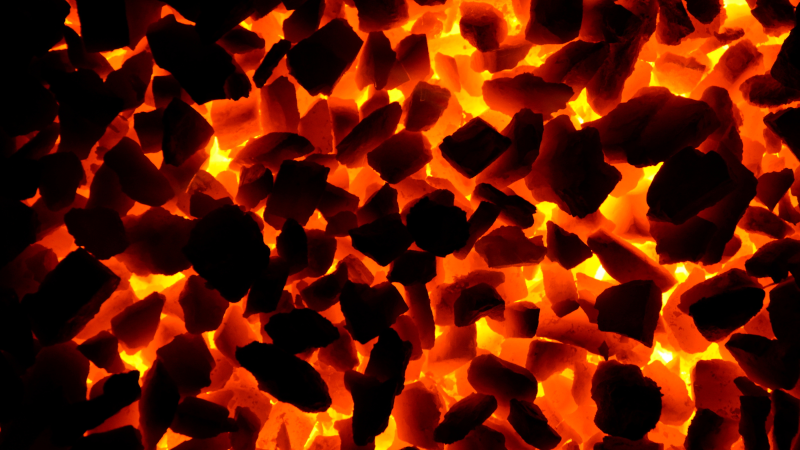For most of history, the world got along fine without the rare earth elements. We knew they existed, we knew they weren’t really all that rare, and we really didn’t have much use for them — until we discovered just how useful they are and made ourselves absolutely dependent on them, to the point where not having them would literally grind the world to a halt.
This dependency has spurred a search for caches of rare earth elements in the strangest of places, from muddy sediments on the sea floor to asteroids. But there’s one potential source that’s much closer to home: coal ash waste. According to a study from the University of Texas Austin, the 5 gigatonnes of coal ash produced in the United States between 1950 and 2021 might contain as much as $8.4 billion worth of REEYSc — that’s the 16 lanthanide rare earth elements plus yttrium and scandium, transition metals that aren’t strictly rare earths but are geologically associated with them and useful in many of the same ways.
The study finds that about 70% of this coal ash largesse could still be accessible in the landfills and ponds in which it was dumped after being used for electrical generation or other industrial processes; the remainder is locked away in materials like asphalt and concrete, where it was used as a filler. The concentration of REEYSc in ash waste depends on where the coal was mined and ranges from 264 mg/kg for Powder River coal to 431 mg/kg for coal from the Appalachian Basin. Oddly, they find that recovery rates are inversely proportional to the richness of the ash.
The study doesn’t discuss any specific methods for recovery of REEYSc from coal ash at the industrial scale, but it does reference an earlier paper that mentions possible methods we’ve seen before in our Mining and Refining series, including physical beneficiation, which separates the desired minerals from the waste material using properties such as shape, size, or density, and hydrometallurgical methods such as acid leaching or ion exchange. The paper also doesn’t mention how these elements accumulated in the coal ash in the first place, although we assume that Carboniferous-period plants bioaccumulated the minerals before they died and started turning into coal.
Of course, this is just preliminary research, and no attempt has yet been made to commercialize rare earth extraction from coal ash. There are probably serious technical and regulatory hurdles, not least of which would be valid concerns for the environmental impacts of disturbing long-ignored ash piles. On the other hand, the study mentions “mine-mouth” power plants, where mines and generating plants were colocated as possibly the ideal place to exploit since ash was used to backfill the mine works right on the same site.

















If there is that much in the ash, I wonder how much is in the unburned coal?
Not very much of course. When coal is burned, the ashes left over are just a few percent of the total mass, so in the coal, the concentrations of these rare earths (which do not burn or evaporate) is about 100x lower.
A bit analog to this, consider burning wood.
During it’s life a tree collects a lot of solar energy, and captures CO2 from the air, and binds it with hydrogen from water (the oxygen is discarded). When the tree is burned, the solar energy is released as heat, and the CO2 is released into the air again. The ashes left is pretty much the fertilizer the tree took out of the ground, and can be used as fertilizer again to grow a new tree.
Any documentation on this? One of the worst emissions from coal fired plants is mercury. If mercury is going up the stack, what else is?
Rare earth oxides tend to be refractory, so they remain with the other ash.
Correct, an example of this would be what’s left after you fire up a gas mantle lantern after you install a new mantle. The fibers burn away leaving behind the Yttrium salts in the shape of the mantle.
Production of coal ash and fly ash is a concentration process where the low-value element (carbon) is burnt off, leaving heavy metals and other oxides. Even after fly ash capture, with just 1% of the heavies escaping up the stack, it’s well documented that coal power plants release more radioactivity into the environment than nuclear power plants.
Which makes you think: Is processing of coal ash to extract uranium for fuel cost effective? Apparently, depending on the coal, it is: https://doi.org/10.1016/j.resourpol.2015.04.005
Damn good question. It might make processing the coal to where it was as desirable as natural gas for fast start up generators economically viable. And allow pipeline transport with a large net increase in efficiency.
There are a lot of designs for coal powered generation which are not economic because of the processing cost preparing the coal. Another possibility is extracting the elements from the flue gas.
If there is that much in the ash, likely a lot more went up the smokestack as pollution instead of captured as product. There wasn’t the current demand for lithium, so very likely no one researched the subject.
At the end of the day, what matters is the overall economics. Can you do it at a price people can afford?
I’d find it quite hilarious if burning coal to generate electricity and extract lithium became the most economically efficient form of transport.
Rare earth metals arent actually rare. We have plenty of them available we’ve just exported the mining of them to other countries where they can exploit essentially slave labor to source the ore.
Yeah, rare earths are a meme. What are they even used for? Neodymium fridge magnets?
Big electric motors don’t use em. Silicon chips don’t use em. What’s the big deal? Worst case just use alnico.
There is demand, so they will be extracted. You seem to be under the impression we can “just use” something (aka everyone spontaneously decides to take a course based on rational thought instead of mass market forces)
They’re called rare not because there’s not much of them globally, but because there’s no ores where they are particularly dense. Something like iron can be present at more than 15% in a given ore, but rare earth elements never get above parts-per-million.
If they made up even 0.01% of fly ash (eg), it would be far richer than any natural ore.
It’s right there in the article. They make up 264 mg/kg to 431 mg/kg which is 0.0264% to 0.0431% assuming I’ve got my decimals correct.
So, isn’t this saying that there is possibly $1.68 worth of rare earth elements per ton of coal ash.
5 gigatons == possibly $8.4 billion
$1.68 per ton processed seems very expensive to me but I don’t know extraction costs.
Considering there are literal mountains of coal ash it has to be among the cheapest way to extract these elements with a tracked excavator and dump trucks, when you compare the cost of operating a subterranian mine with wooden supports railways, elevators and all that entails.
Supports in the mines?! Don’t worry, the places they mine them don’t have health and safety…
Not since we made it illegal to do in the US, no
Depends on the contents. Rare earths oxide commodity prices vary a lot depending on the type, anywhere from 50 cents/kg to several hundred dollars per kg. 0.43% grade (per the article) is for a mid range oxide like neodymium is about $22 per tonne of processed ore.
For comparison, titanium dioxide has a commodity price of between 2 and $3 a kilo, depending on the market. Mineral sands mines( from which TiO2 is derived) typically have grades in the 0.5-3% range. So the return is ~$6-20 per tonne processed. I chose titanium because its mining most closely resembles the topic of discussion, ie. a free standing tailing pile with fly ash containing rare earths, versus the hardrock mining most people envision when thinking of mining.
So it’s a comparable or better yield for an “orebody” you can “mine” by driving up to it with a front end loader and scooping it up. Definitely worth a look. Especially if trade wars and politics drive prices up.
Nope got my grade wrong. 0.043% not 0.43%, and the recoveries are uneven. Looks like the two examples given provide a reasonable estimate of 0.015% grade, recoverable. That said, I read the paper (and then the SciTech Daily article) and there are some inconsistencies. The paper claims grades of 1-3% in fly ash, which is at least 20x higher and changes the calculus a lot. The 5 GT mentioned in the HaD articles appears nowhere in either the paper or the article (unless HaD is paying Elsevier to read the full paper and has access to details that aren’t in the linked webpage). So I don’t know where that came from. The articles says 1.8 GT (or possible 1.3, the wording is ambiguous) of coal ash is potentially recoverable. Using all the lowest numbers for grade, recovery and volume, that gives a total of 3,930,000 tonnes of REOs. I’m going to assume the articles 11 million tonnes is based on actual values vs my lowest listed values. But $8 billion dollars is very conservative unless there’s something about the product that makes it less valuable. Most REO (rare earth oxides) sell for 10s of thousands of dollars a tonne, and the rest are usually at least $1500 – 2000 a tonne.
Although the publication states “coal-derived ash is relatively free of radioactive substances compared to the radioactive elements (Th and U) released with the conventional REE ores utilization”, coal fly ash also contains radioactive potassium-40 and radioactive decay products (including radium) from uranium, and thorium isotopes. This was an issue raised 2-3 decades ago when fly ash was being used as a component in concrete used in the construction of apartment and office buildings, in which people would receive an additional radiation dose.
Furthermore, depending on the specific methods for recovery of REE/Yttrium/Scandium, there may be a concentration or precipitation of the radioactive materials in one or more of the separation steps (e.g., scale buildup in a container). If these concentrations exceeded certain regulated alpha/beta/gamma levels, such materials may be classified as low-level radioactive waste. If the material contains both hazardous (certain acid or organic) and radioactive components, it may have to be treated as “low-level mixed waste”.
Apparently not everyone got the Banana Memo.
Let’s be generous and say 1/2 gram of the money elements per 1,000 grams are recovered. As the article points out, it ain’t all lithium, and lithium isn’t even a rare earth.
What means “Oddly, they find that recovery rates are inversely proportional to the richness of the ash.” What is “the richness of the ash”? Can it be expressed with numbers?
The number would be what percentage of the ash is made up of whatever element you’re interested in. (Or it might be given as the number of grams of the element per ton of ash or similar)
Thank you. Maybe now you can help me with “the more there is of what you want, the less you get of what there is.”
“Oddly, they find that recovery rates are inversely proportional to the richness of the ash.”
I just happen to have some coal ash here, fresh out of my fire in a ziplock bag.
So I stuck it next to my Geiger counter. Normal background on the cheap counter is 0.10usv/h
With 50g of coal ash next to the tube, I’m getting 0.10usv/h (average over 5 mins). If it’s radioactive, it’s below the sensitivity of my counter (and below background levels). I know, it’s a small sample, and ignores alpha. Also it might be that you get concentrations, so my sample might just be on the low side by chance. I could try screening bigger samples for “hot spots”. I think the granite work top in the kitchen is worse, tbh. (Don’t tell the wife though!)
The coal is probably from Poland.
Coal from my country is – relatively – free of sulphur, but is uranium rich(same goes for ash).
I seem to remember that someone did a calculation that the energy content of the fissionable materials (U and Th) in fly ash, and determined that the energy content of those materials was higher than the energy content of the carbon that was burned. John McCarthy, the father of LISP, used to say that the energy density of uranium was so high that it was thermodynamically efficient to separate a single atom of Uranium from its source. People do not seem to appreciate the concept of energy density. So, we need to start mining that fly ash, for “rare” earth elements, and fissionables.
I’m curious if there is something special about coal ash, or if this is just a case of big numbers. Extracting $8B out of 5 gigatonnes of material does not seem like a particularly rich source to me. By my naive math, that’s like 1/1000th the value you could create if you were able to just convert the ash into construction bricks.
I.E. if you have 5 gigatonnes of mass you will find many interesting atoms. Doesn’t mean it’s a good way to get them, or even a good way to use that mass.
Yes, but making bricks is very energy intensive.
Coal ash is a pozzolan, so not really. It’ll stick together with some lime.
It makes, associated with lime and clay (with the adequate ratio of sand), an excellent geopolymer. Not need to fire it like bricks, it just gets harder with time.
Ash is considered slightly radioactive. Remove all the “good” elements like uranium, lithium and potassium, then use the rest as material for inert bricks. Double win.
Burning things to separate refractory materials is a way to refine them… If you’re going to be burning gigatons of the ore anyway for a separate purpose, you may as well make use of the concentration of valuable minerals which occurs as a side-effect
US$1.68 of refined element value per ton? Now cost out the transportation and specialized refining required to even get that small return from the widely distributed legacy ash piles.
I mean what is the cost per ton of dirt and rock in a traditional mine? That seems like the relevant question
Depends on lots of things, but $35 – 75 per tonne, on the train, is pretty reasonable for a hard rock mine. Also these are price for the oxides not the refined element. And its not $1.68 per tonne. Those number aren’t in the paper or the linked article. Its $8.3 billion dollars for 11 million tonnes of REOs derived from 1.8 (or 1.3 depending on how you parse the sentence) billion tonnes of ash.
Thank you for writing about this interesting possibility. I hope you will forgive my post, that it might act as a lightning-rod for fellow pedants.
Begging your pardon, then; I believe the world would keep on spinning. Indeed, even if we defined the world as that existence perceived by humans (a sort of “Plato’s Cave” scenario), for the vast majority of humans it would continue to spin, and rotate about it’s sun.
Peace; out.
8 billion in all this ash? i do not think it is cost effective to recover it. now if it was a drive with bitcoin. ;-)
There’s a bitcoin in the ash pile, I promise. You have to find it
It’s not 8 billion it’s 6 gorillion. We’ll take your ash and you will pay us for it goyim. That’s the Torah way ✡️
AFAIK coal ash (depending on location) has been a preferred source of gallium for quite some time